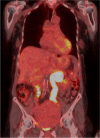IGF-2 mediated hypoglycemia and the paradox of an apparently benign lesion: a case report & review of the literature
- PMID: 36303203
- PMCID: PMC9615362
- DOI: 10.1186/s12902-022-01175-4
IGF-2 mediated hypoglycemia and the paradox of an apparently benign lesion: a case report & review of the literature
Abstract
Background: Non-islet cell tumour hypoglycemia (NICTH) is rarely encountered in clinical practice. Insulin-like growth factor 2 (IGF2) is the most common cause of NICTH observed in the setting of mesenchymal and epithelial neoplasia. This is a paraneoplastic syndrome caused by IGF2 activation of the insulin receptor.
Case presentation: An 80 year old female presented with a short history of recurrent episodes of confusion with laboratory confirmed hypoglycemia with a plasma glucose of 2.7 mmol/L on fasting which fulfilled Whipple's triad. Diagnostic clues to the aetiology at presentation include the fasting pattern of hypoglycemia, hypokalaemia and the absence of weight gain. A 72 hour fast with results showed early hypoglycemia and suppression of serum insulin, c-peptide, and proinsulin. Serum insulin antibody was not detected. Subsequent measurement of the serum IGF2:IGF1 ratio was elevated at 22.3 and consistent with IGF-2 mediated hypoglycemia and imaging studies demonstrated a pelvic mass. Dietary intervention and oral prednisolone abated hypoglycemia prior to surgery. Ultimately, hypoglycemia resolved following operative intervention and steroid therapy was successfully withdrawn. Histopathology was remarkable for dual neoplastic processes with uterine solitary fibrous tumour (SFT) confirmed as the source of IGF2 hypersecretion on IGF-2 immunohistochemistry and a coincidental invasive high grade serous carcinoma involving the fimbria of the right fallopian tube.
Conclusion: The paradox in this case is that the benign solitary fibrous tumour accounted for patient morbidity through secretion of IGF2 and without treatment, posed a mortality risk. This is despite the synchronous presence of a highly malignant fallopian tube neoplasm. This case reinforces the need for thorough clinical evaluation of hypoglycemia to allow prompt and definitive management.
Keywords: Hypoglycemia; Insulin-like growth factor 2; Non-islet cell tumour hypoglycemia.
© 2022. The Author(s).
Conflict of interest statement
The authors declare that they have no competing interests.
Figures
Similar articles
-
Hypoglycemia mediated by paraneoplastic production of Insulin like growth factor-2 from a malignant renal solitary fibrous tumor - clinical case and literature review.BMC Endocr Disord. 2014 Jun 17;14:49. doi: 10.1186/1472-6823-14-49. BMC Endocr Disord. 2014. PMID: 24934576 Free PMC article.
-
Imbalanced Expression of IGF2 and PCSK4 Is Associated With Overproduction of Big IGF2 in SFT With NICTH: A Pilot Study.J Clin Endocrinol Metab. 2018 Jul 1;103(7):2728-2734. doi: 10.1210/jc.2018-00593. J Clin Endocrinol Metab. 2018. PMID: 29897468
-
A case of insulin-like growth factor 2-producing gastrointestinal stromal tumor with severe hypoglycemia.BMC Endocr Disord. 2020 May 11;20(1):60. doi: 10.1186/s12902-020-0529-2. BMC Endocr Disord. 2020. PMID: 32393233 Free PMC article.
-
Recurrent Non-islet Cell Tumor Hypoglycemia Secondary to Hepatocellular Carcinoma: Case Report and Literature Review.Z Gastroenterol. 2024 May;62(5):752-758. doi: 10.1055/a-2170-1691. Epub 2023 Oct 5. Z Gastroenterol. 2024. PMID: 37798922 Review. English.
-
Doege-Potter syndrome in a patient with a giant abdominal solitary fibrous tumor: a case report and review of the literature.Acta Clin Belg. 2023 Aug;78(4):358-364. doi: 10.1080/17843286.2023.2165652. Epub 2023 Jan 15. Acta Clin Belg. 2023. PMID: 36641633 Review.
Cited by
-
Solitary fibrous tumor with IGF-II-induced non-islet cell tumor hypoglycemia: a case report and molecular characterization by next-generation sequencing.Front Oncol. 2023 Jul 4;13:1188579. doi: 10.3389/fonc.2023.1188579. eCollection 2023. Front Oncol. 2023. PMID: 37469410 Free PMC article.
-
Non-islet cell tumor hypoglycemia (NICTH) associated with sarcoma, case report.BMC Endocr Disord. 2025 Mar 5;25(1):59. doi: 10.1186/s12902-025-01885-5. BMC Endocr Disord. 2025. PMID: 40045285 Free PMC article.
-
Adrenocortical Carcinoma With 2 Distinct Syndromes From Secretion of Insulin-Like Growth Factor 2 and Steroid Hormones.JCEM Case Rep. 2025 Apr 23;3(6):luaf078. doi: 10.1210/jcemcr/luaf078. eCollection 2025 Jun. JCEM Case Rep. 2025. PMID: 40270996 Free PMC article.
-
Recurrent Hypoglycemia in a 67-Year-Old Woman with CD5- Positive Diffuse Large B-Cell Lymphoma.Clin Med Insights Case Rep. 2024 Aug 13;17:11795476241271540. doi: 10.1177/11795476241271540. eCollection 2024. Clin Med Insights Case Rep. 2024. PMID: 39148706 Free PMC article.
-
Retroperitoneal Doege-Potter syndrome with intraoperative blood glucose monitoring.IJU Case Rep. 2024 Jul 30;7(5):391-394. doi: 10.1002/iju5.12765. eCollection 2024 Sep. IJU Case Rep. 2024. PMID: 39224681 Free PMC article.
References
-
- Whipple AO. The surgical therapy of hyperinsulinism. J Int Chir. 1938;3:237–276.
Publication types
MeSH terms
Substances
LinkOut - more resources
Full Text Sources
Medical
Miscellaneous




